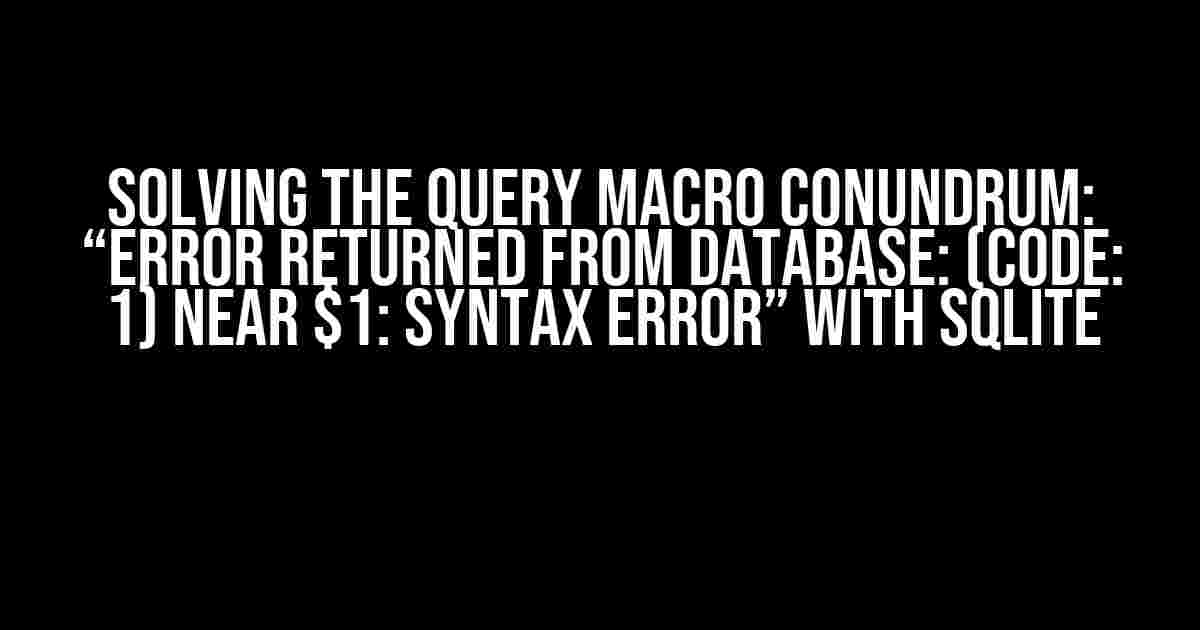If you’re reading this, chances are you’ve stumbled upon a frustrating error message while working with query macros in SQLite. The infamous “Error Returned from Database: (Code: 1) Near $1: Syntax Error” has got you stumped, and you’re not alone! In this article, we’ll delve into the world of query macros, explore the common causes of this error, and provide you with practical solutions to get your queries up and running smoothly.
What are Query Macros, Anyway?
-- A simple query macro example
CREATE MACRO my_macro(a, b) AS
SELECT * FROM my_table WHERE column_a = a AND column_b = b;
In this example, we’ve created a query macro called `my_macro` that takes two parameters, `a` and `b`. The macro is essentially a template that can be reused throughout your application with different input values.
The Anatomy of the Error
Error returned from database: (code: 1) near "$1": syntax error
Common Causes of the Error
- Incorrect macro definition: A malformed macro definition can lead to syntax errors when the macro is invoked. Double-check that your macro is defined correctly, paying attention to syntax, parameter ordering, and any typos.
- Parameter mismatch: When invoking a macro, ensure that the number and data types of the input parameters match the macro’s definition. A mismatch can lead to syntax errors.
- SQL syntax errors: The query itself might contain syntax errors, which are then amplified when passed through a macro. Verify that the underlying query is valid and free of errors.
- Macro invocation issues: The way you’re invoking the macro might be incorrect. Check that you’re using the correct syntax and providing the required parameters.
Troubleshooting and Solutions
Step 1: Review Macro Definitions
-- Corrected macro definition
CREATE MACRO my_macro(a, b) AS
SELECT * FROM my_table WHERE column_a = :a AND column_b = :b;
Step 2: Verify Parameter Mismatch
-- Corrected macro invocation
EXECUTE my_macro('value_a', 'value_b');
Step 3: Inspect the Underlying Query
-- Test the underlying query
SELECT * FROM my_table WHERE column_a = 'value_a' AND column_b = 'value_b';
Step 4: Check Macro Invocation Syntax
-- Corrected macro invocation syntax
dbc.execute("SELECT * FROM my_macro('value_a', 'value_b')");
Additional Tips and Best Practices
- Use named parameters: Instead of relying on positional parameters ($1, $2, etc.), use named parameters (:a, :b, etc.) for clearer and more maintainable code.
- Test macros independently: Before integrating a macro into your application, test it independently to ensure it works as expected.
- Use a consistent naming convention: Establish a consistent naming convention for your macros and underlying tables to avoid confusion and errors.
- Document your macros: Keep a record of your macros, including their definitions, parameters, and usage examples. This will help you and your team members understand the macros and troubleshoot issues more efficiently.
Conclusion
With these solutions and tips in hand, you’re ready to tackle the world of query macros and SQLite with confidence. Happy coding!
| Macro Definition | Corrected Macro Definition |
|---|---|
CREATE MACRO my_macro(a, b) AS SELECT * FROM my_table WHERE column_a = $1 AND column_b = $2; |
CREATE MACRO my_macro(a, b) AS SELECT * FROM my_table WHERE column_a = :a AND column_b = :b; |
By using named parameters and adopting a consistent naming convention, you can avoid common pitfalls and make your code more readable and maintainable.
- Review macro definitions and invocation syntax
- Verify parameter mismatch and correct as needed
- Inspect the underlying query for syntax errors
- Check macro invocation syntax and correct as needed
- Adopt best practices for macro usage and maintenance
By following these steps and tips, you’ll be well on your way to resolving the “Error Returned from Database: (Code: 1) Near $1: Syntax Error” and unlocking the full potential of query macros in SQLite.
Here are 5 Questions and Answers about “Query macro gives "error returned from database: (code: 1) near $1: syntax error" with sqlite”:
Frequently Asked Question
Got stuck with SQLite errors? We’ve got your back! Here are some answers to common questions about query macros and syntax errors.
What does the error “error returned from database: (code: 1) near $1: syntax error” mean?
This error usually indicates that there’s a problem with the SQL syntax in your query macro. It’s like trying to speak a language with incorrect grammar – the database can’t understand what you’re trying to say! Check your query for typos, missing quotes, or invalid SQL syntax.
How do I identify the problem in my query macro?
Take a closer look at the error message. The “(code: 1) near $1” part is giving you a hint. The “$1” refers to the position in your query where the error occurred. Check the SQL syntax around that position, and you might find the culprit. You can also try breaking down your query into smaller parts to isolate the issue.
Can I use a query builder to avoid syntax errors?
Yes! Using a query builder can help you avoid syntax errors. These tools can automatically generate the SQL syntax for you, reducing the chance of typos or incorrect syntax. Plus, they often provide a more intuitive way to build your queries. Give it a try and see how it can simplify your life!
What if I’m using a parameterized query and still getting the error?
Parameterized queries are great for avoiding SQL injection, but they can still produce syntax errors if the parameter values are not properly formatted. Make sure to check the data type and formatting of your parameter values. Additionally, verify that the parameter names in your query match the ones in your code.
How can I test my query macro to ensure it’s working correctly?
Test, test, test! Try running your query macro with sample data to see if it produces the desired results. You can also use a tool like SQLite Studio or DB Browser to execute your query and inspect the results. This will help you catch any errors or unexpected behavior before deploying your code.
I hope this helps!
